Motorhome advice: Motorhome and campervan water systems explained
Words and pictures: Peter Rosenthal
Most motorhomes (and many campervans) have a fixed fresh water tank onboard that’s filled up by physically moving the vehicle to within a hosepipe-filling length of a water tap. The fresh water tank is connected to a pump and series of hoses and taps, as well as feeding the hot water tank (often built into the heating system with a Truma Combi unit).
When you open a tap, the pump is activated – either via a pressure switch or a microswitch in the tap body – and water flows. It exits back through the vehicle’s plumbing into a grey waste water tank, which can then be drained by driving over a suitable drainage point on a campsite and emptying it.
A-class motorhomes and RVs can sometimes have a black waste water tank that’s connected to the toilet sewerage system, rather than a toilet cassette. Black waste needs to be emptied out at a campsite that has a specific black waste dump point, so many owners add a macerator, which allows them to dump black waste at a normal waste empty point (with the campsite owner’s permission).
Any motorhome can be prepared and adapted for a one-off winter trip (when water systems are vulnerable to the cold), so it’s more important to consider where it is kept for the majority of the time when it comes to specifying a water system. If you live in Cornwall, there’s less of a need for a heated water tank than if you live in the Scottish Highlands.
Equally, if you use your motorhome all year around and love skiing in the winter, then you’ll have different needs to those who simply like to amble around the south of France in August.
The main components of a motorhome water system
Fresh water tanks
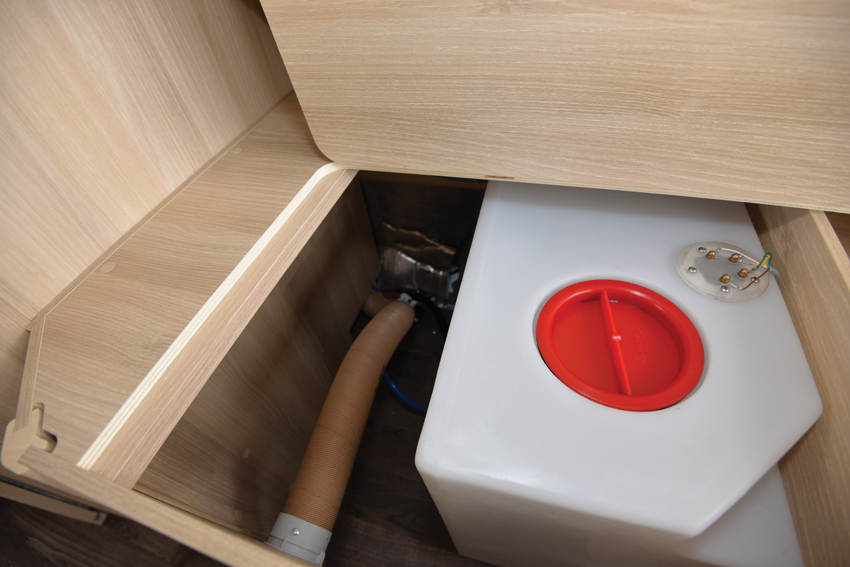
The placement of the water tank depends upon the size of the vehicle, its layout and axle load limits.
A typical coachbuilt motorhome and larger campervan will have a fresh water tank inside the habitation area – often under the rear travel seats – where it can be centrally located for weight distribution and proximity to all the taps. The closer the water tank is to the taps, the less plumbing and connection points are needed.
Being inside the habitation area means the water is unlikely to freeze and will be better insulated from the elements as it sits on top of the thick insulated floor.
Some vehicles – usually smaller campervans – may have the water tank underneath the floor and this is fine, as long as it’s insulated and protected from road debris. If you live in an area that freezes or enjoy winter holidays, then tick the option box for an additional water tank heating element. These tank heating elements can be retrofitted but as these require a 12V feed you may need to increase the 12V battery capacity.
While most water tanks are rectangular, they can be any shape to fit in a certain space and firms such as Cak Tanks can make a tank in almost any shape or size.
If you only have a smaller campervan without a shower, then your water requirements will be quite low and a removable tank of around 20 litres may suffice. Removable tanks are easier to clean and fill up. In winter they can be removed to reduce the chance of freezing.
The best method of installing water tanks is to sandwich them between a heated double floor system and this is the method employed by most high-end motorhome manufacturers. It eliminates most freezing issues and protects the tanks from road debris.
Filling a motorhome fresh water tank
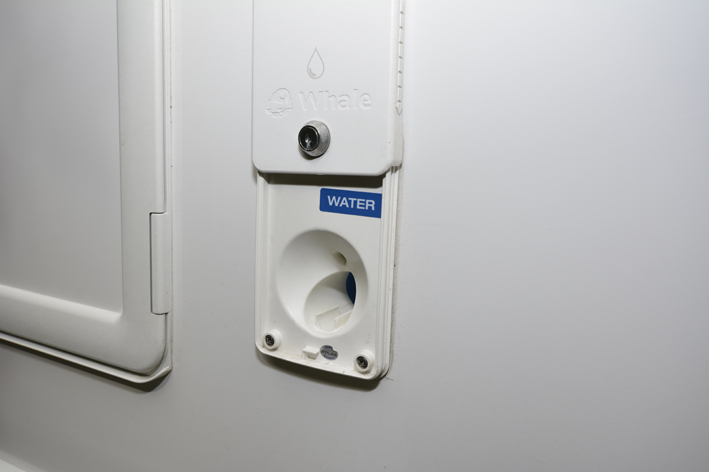
If your motorhome has a fixed water tank then filling it up is a case of moving close to a water tap or connecting a hose to your pitch’s mains service point. Most campsite taps have a threaded end to accept Hozelock-style fittings, so it’s best to pack a selection of male and female connectors.
Any hose that runs from the tap to the motorhome ideally needs to be food-grade to avoid any plastic leaching into the water tank. Some people fill up their water tank with a garden hose pipe, which is less than ideal (definitely don’t drink it).
A motorhome dealer can supply a food-grade water filling kit with a selection of fittings for around £20.
Most motorhome water tanks have a 100-litre capacity, so filling them can take an age. You can get around this by buying a replacement filler cap with a Hoselock-style connector built into it – these cost £10 to £20 online. Just clip the hose pipe on and switch on the tap. When water starts overflowing out of the vented cap (or the tank overflow), the tank is full.
Tainted water in motorhomes
Do not drink the water from your fresh water tank unless it has been boiled in a kettle or it has been filtered. While the fresh water tank and all the plumbing of a motorhome use food-grade components they do still pick up mild plastic odours and musty smells.
Water sat in a tank will smell if left for long periods, so always drain it down over winter lay-up. Slimy residues also build up in standing water and these need to be cleaned off at the start of the season. Most water tanks have large inspection hatches for this purpose.
Bacteria, films and moulds need heat and moisture to thrive so, if the tank is dry, it reduces their build up.
In use, with lots of fresh water sloshing around the tank, this is less of an issue.
To sterilise your water system, you can add a cleaning agent to your water tank – such as Puriclean – and then open up each water tap or shower head in turn to flush it through. Start with the tap furthest away from the tank and leave the fluid in the system overnight before flushing it out with fresh water. It’s a good idea to take the vehicle for a drive so that the sterilising fluid can slosh into every corner of the water system.
With any sterilising agent, check that it is compatible with your vehicle’s water heater (read the manual) – some baby and domestic sterilising products are not recommended for motorhomes.
You can also buy cleaning products for your cassette toilet tank but only use products recommended by the toilet maker to avoid damage to the rubber seals.
Adding a motorhome water filter
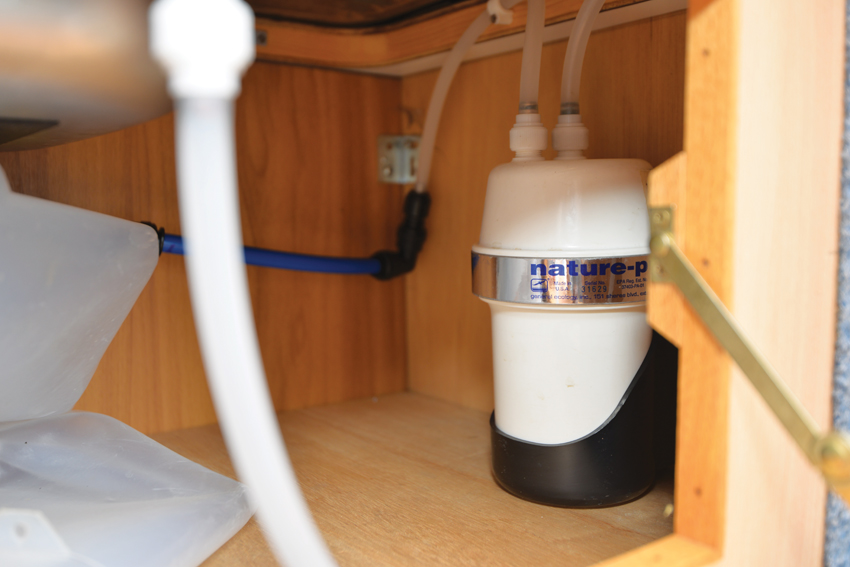
Rather than using bottled water to drink or fill the kettle with, you can also add a filter to your water system. There are various brands on the market and you can either add them inline to your existing water tap (most people use the kitchen sink tap) or add a second tap system. Water filters can remove harmful nasties in the water and can be helpful if you have to fill up from an unclean source.
Filters must be changed regularly so make sure you fit the filter where it is easily accessible and know the cost of replacement filters before you invest in a system.
Also we suggest removing the water filter during winter lay-up (or loosen a hose to it) as any trapped water may freeze and crack the housing.
Motorhome waste water tanks
The considerations for waste water tanks are similar to those for fresh water tanks, so ensure they’re well insulated or heated (many winter motorhomers leave the drain taps open and use a bucket for the waste water to drain into).
Waste water tanks are often underslung and can be into tight spaces underneath the motorhome or campervan. This can mean that they’re an odd shape so they may need you to make sure the vehicle is level to drain them.
Any underslung water tank is also more prone to damage due to water debris or getting scraped on the ground so they need to be checked regularly for leaks or damaged piping.
How do I drain a motorhome waste tank?
Draining a waste water tank can be fiddly, especially if the tank is awkwardly placed and has fiddly taps. It’s best to have an assistant help you to position the drain valve over the campsite empty point, but this isn’t always possible. Therefore, it’s best to attach a section of hosepipe (or a cut-up bicycle inner tube) to the end of the drain valve so you can easily get the waste water into the drain point.
We suggest packing disposable gloves, too, as external water taps do get grubby.
How much water is left in my motorhome tank?
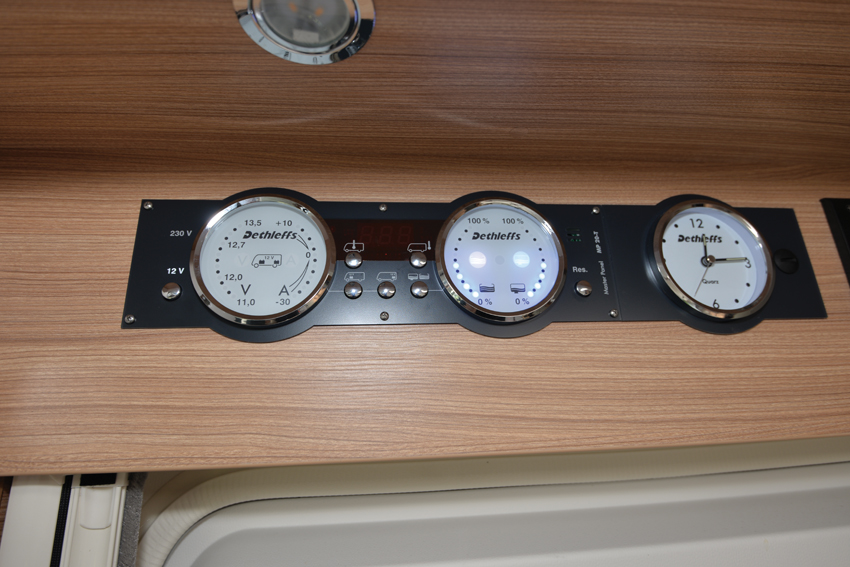 Measuring the level of fluid in a tank is a challenge and makers use a variety of systems to achieve this. These range from simple float devices that can vary their resistance as the water level changes, to individual prongs of different lengths that sense when they’re immersed in water. Some systems also have a couple of studs bolted to the side of a waste water tank to indicate when it needs emptying.
Measuring the level of fluid in a tank is a challenge and makers use a variety of systems to achieve this. These range from simple float devices that can vary their resistance as the water level changes, to individual prongs of different lengths that sense when they’re immersed in water. Some systems also have a couple of studs bolted to the side of a waste water tank to indicate when it needs emptying.
Some display panels indicate water level via a series of LEDs, some use a separate analogue gauge, while others have digital displays.
No matter what the type of display, it will only be as accurate as its calibration, so check how accurate it is when the tank gets low.
With a new motorhome, find the location of your fresh water tank’s inspection hatch, open it and fill the water tank to about one-quarter full. Then check that the gauge also reads one-quarter full. If it doesn’t, see how the gauge can be adjusted.
Motorhome plumbing pipes
All the pipes will be food-grade plastic and are blue or red tubing, denoting cold and hot respectively, or clear piping striped with red or blue flashes.
Some motorhomes use jubilee clips to secure water pipes to the barbed fittings of taps and ancillaries, but most modern models use semi-rigid hose and push-fit connectors.
These are similar to some domestic systems and the semi-rigid hose push-fits into the end of the connectors and appliances (it can be easily removed by pushing the collet in).
If you’re fitting or renewing any semi-rigid hoses, the ends must be cut squarely using a pipe-cutting tool – cutting the hose with a knife or a hacksaw will give the pipe an uneven edge and will cause the fitting to leak.
Any plumbing that runs externally should be insulated. This isn’t always the case with waste water plumbing but this is not a major issue as external insulation is easy to add.
What types of motorhome water pumps are there?
Most motorhomes use one of two kinds of water pump. Pressure-activated pumps are switched on when their pressure sensor detects a drop in water pressure when a tap is opened or the loo flushed. These are often external to the fresh water tank and the pressure sensor is adjustable.
They’re generally reliable but be aware that, if you have a water leak, they can activate automatically and pump water out of any hole or detached hose connector. Draining down over winter, and switching the water pump off when it’s not in use can prevent this.
The tell-tale sign of a water leak (or a failing water pump pressure switch) is if the pump keeps switching on and off when no taps are open. If a water pump does this, try adjusting the pressure valve to see if it stops the pump actuating. If it doesn’t and you’ve checked for any leakage, then suspect the pressure switch.
The other common type of water pump is one triggered by on/off microswitches located in each tap. These can be either mounted externally near the water tank or submersed in the tank itself.
Water pumps are generally reliable, but the microswitches on the taps can fail. If the water pump works on the kitchen tap, but not on the washroom basin, then it suggests the washroom tap has failed or has a wiring issue.
It’s easy to check if a microswitch tap works with a multimeter. Set the multimeter to its continuity setting and connect its probes to either end of the two wires coming out of the tap. If the meter doesn’t beep or indicate a connection when the tap is opened, the microswitch has failed and the tap will need replacing. Taps are generally easy to replace, but this depends on the access underneath them.
How do I prevent frost damage to my motorhome water system?
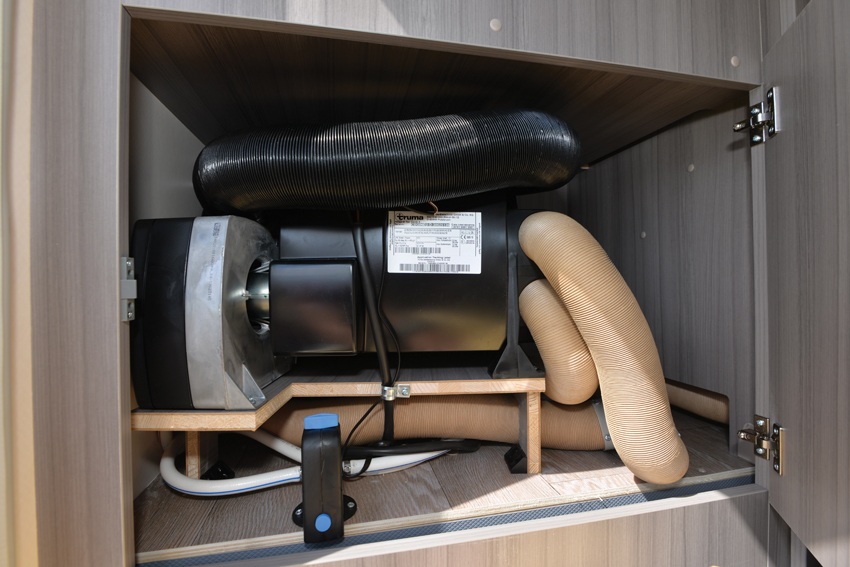
Most modern motorhomes have temperature-activated valves that automatically drain off the water tank and hot water tank in cold conditions. These work well, but don’t get into the habit of relying on them.
Even if the tank drain valve has emptied the water tanks that doesn’t mean the motorhome is fully frost protected – any part of the system where water can be trapped (between the water pump and kitchen tap) can cause an issue. As water freezes it expands and can split the housing it is contained in.
Read the owner’s manual for the correct winter drain-down procedure. Most involve opening the drain valve in the fresh water tank and the waste water tank, as well as opening up all the sink taps and shower taps. Then run the water pump until your hear it running dry (then switch it off immediately).
You can also buy air bleed valves that allow you to evacuate all water out of the system using compressed air. Remember to remove any water filter system parts over winter, too.
To recommission the system, close all the drain valves, switch off all the taps and refill the water tank. Then open the tap furthest away from the water tank and keep it open until it gives a steady flow. Repeat this procedure for each tap and the shower head. Most water pumps will self-prime very easily.
Recommended reading: check out our guide to draining your motorhome's water systems












Recent Updates
Engine management lights: all you need to know
What is the engine management light? What does it mean, and what do I have to do? ...
Motorhome air suspension: all you need to know
Motorhomes are heavy and the additional weight of equipment and height of the bodywork can increase the loads ...
Motorhome WiFi: how to get better motorhome internet
Staying connected on the move is more and more essential, so relying on campsite WiFi isn't an option – here ...
A class of their own - our guide to A-class motorhomes
Thinking of trading up to an A-class, or even going straight to the top of the motorhome tree? We guide you ...
Explore overseas on a motorhome dream tour
Enjoy exotic travel in a campervan or motorhome by hiring, swapping with someone else or exporting your ...
Motorhome water systems: everything you need to know
On-board water is an important part of every motorhome – here’s everything you need to know ...
Campervanning in Europe: what you need to know
Whether you're planning a leisurely drive through the French countryside, navigating bustling city streets in ...
Campervan security: all you need to know
With thefts on the increase, it’s important to know how to keep your campervan secure and prevent campervan ...
Campervan furniture: everything you need to know
Our campervan experts guide you through all the essentials for your campervan, including tables, chairs, ...
Campervan finance: how to fund your purchase
Here we look at the different types of campervan finance available, to help you decide what’s the best option ...
Other Articles
Britain’s best used motorhomes
Want a great motorhome without paying the premium for a new one? Here's a guide to the best you can get in the pre-owned market for each layout, ...
Which motorhome? Choosing the perfect motorhome for you
Choosing a motorhome or campervan is one of the biggest buying decisions you’ll ever make, so it's important ...
Campervan washroom essentials: stay fresh on the road
Our guide will take you through the campervan washroom essentials you'll need so you're well-prepared for ...
Dogs in campervans: all you need to know
Follow our advice and your dog will enjoy campervanning as much as you do ...
Electric campervans: all you need to know
Our guide will take you through everything you need to know about electric campervans and what the future ...
Motorhome electrics: a complete guide to your motorhome electrical set-up
Motorhome electrics can dramatically enhance the convenience and comfort of your vehicle – but they can be ...
Lighting for campervans: all you need to know
We guide you through all the lighting options available for you and your campervan, including interior ...
Electric bikes for motorhomes: our ultimate guide
Read our comprehensive guide to electric bikes for motorhome owners, helping you add electric power to your ...
Our guide to 'cheap' motorhomes in 2024
If you're on the hunt for an affordable new motorhome, this is the best place to start – we've rounded up a ...
Campervans in winter: all you need to know
Here's your guide to preparing your campervan for the colder months, whether you will be using it or putting ...